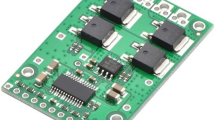Abstract
The current two-dimensional (2D) numerical study presents the melting phenomenon and heat transfer performance of the nanocomposite phase change material (NCPCM) based heat sink. Metallic nanoparticles (copper: Cu) of different volume fractions of 0.00, 0.01, 0.03, and 0.05 were dispersed in RT–28HC, used as a PCM. Transient simulations with conjugate heat transfer and melting/solidification schemes were formulated using finite–volume–method (FVM). The thermal performance and melting process of the NCPCM filled heat sink were evaluated through melting time, heat storage capacity, heat storage density, rate of heat transfer and rate of heat transfer density. The results showed that with the addition of Cu nanoparticles, the rate of heat transfer was increased and melting time was reduced. The reduction in melting time was obtained of − 1.36%, − 1.81%, and − 2.56% at 0.01, 0.03, and 0.05, respectively, compared with 0.00 NCPCM based heat sink. The higher heat storage capacity enhancement of 1.87% and lower reduction of − 7.23% in heat storage density was obtained with 0.01 volume fraction. The enhancement in rate of heat transfer was obtained of 2.86%, 2.19% and 1.63%; and reduction in rate of heat transfer density was obtained of − 6.33%, − 21.05% and − 31.82% with 0.01, 0.03, and 0.05 volume fraction of Cu nanoparticles, respectively. The results suggest that Cu nanoparticles of 0.01 volume fraction has the lower melting rate, higher heat storage capacity and heat transfer rate, lower heat storage density and heat transfer rate density which is preferable for passive cooling electronic components.









Similar content being viewed by others
Abbreviations
- Al2 O 3 :
-
Aluminum oxide
- Cu:
-
Copper
- FVM:
-
Finite volume method
- HS:
-
Heat sink
- ICs:
-
Integrated circuits
- NCPCM:
-
Nanocomposite phase change material
- PCM:
-
Phase change material
- PRESTO:
-
PREssure STaggering Option
- QUICK:
-
Quadratic Upstream Interpolation for Convective Kinematics
- SIMPLE:
-
Semi-Implicit Pressure-Linked Equation
- UDF:
-
User–defined function
- A m :
-
Mushy zone
- B :
-
Boltzman constant (J/K)
- ρ c p :
-
Volumetric heat capacity (J/m3.K)
- f l :
-
Liquid fraction
- g :
-
Gravitational acceleration (m/s2)
- H :
-
Height (mm)
- Q :
-
Heat storage capacity (J)
- q :
-
heat storage density (J/kg)
- k :
-
Thermal conductivity (W/m.K)
- L :
-
Latent heat of fusion (J/kg.k)
- m :
-
Mass (kg)
- p :
-
Pressure (Pa)
- \(\dot {Q}\) :
-
Rate of heat transfer (W )
- \(\dot {q}\) :
-
Rate of heat transfer density (W/kg)
- S :
-
Source term in momentum equation
- T :
-
Temperature (K)
- t :
-
Time (sec)
- u :
-
Velocity component in x −axis (m/s)
- v :
-
Velocity component in y −axis (m/s)
- W :
-
Width (mm)
- c p :
-
Specific heat capacity (J/kg.K)
- ΔH :
-
Fractional latent-heat (J/kg.K)
- 2D :
-
Two dimensional
- φ :
-
Volume fraction
- μ :
-
Viscosity (Pa.s)
- β:
-
Thermal expansion coefficient (1/K)
- HS :
-
Heat sink
- hs :
-
Heat source
- ini :
-
Initial
- l :
-
Liquidus
- m :
-
Melting
- ncpcm :
-
Nanocomposite phase change material
- np :
-
Nanoparticles
- ref :
-
Reference
- x :
-
x −axis
- y :
-
y −axis
References
Murshed SS, de Castro CN (2017) A critical review of traditional and emerging techniques and fluids for electronics cooling. Renew Sust Energ Rev 78:821–833. https://doi.org/10.1016/j.rser.2017.04.112
Pedram M, Nazarian S (2006) Thermal modeling, analysis, and management in VLSI circuits: Principles and methods. Proc IEEE 94(8):1487–1501. https://doi.org/10.1109/jproc.2006.879797
Rathore PKS, Shukla SK (2021) Enhanced thermophysical properties of organic PCM through shape stabilization for thermal energy storage in buildings: a state of the art review. Energy and Build 110799:236. https://doi.org/10.1016/j.enbuild.2021.110799
Adibpour S, Raisi A, Ghasemi B, Sajadi A, Rosengarten G (2021) Experimental investigation of the performance of a sun tracking photovoltaic panel with phase change material. Renew Energy 165:32333. https://doi.org/10.1016/j.renene.2020.11.022
Royo P, Acevedo L, Arnal ÁJ, Diaz-ramírez M, García-armingol T, Ferreira VJ, Ferreira G, López-Sabirón AM (2021) Decision support system of innovative high-temperature latent heat storage for waste heat recovery in the energy-intensive industry. Energies 14(2):365. https://doi.org/10.3390/en14020365
Bentivoglio F, Rouge S, Soriano O, de Sousa AT (2021) Design and operation of a 180 kWh PCM heat storage at the flaubert substation of the grenoble urban heating network. Appl Therm Eng 185:116402. https://doi.org/10.1016/j.applthermaleng.2020.116402
Guelpa E (2021) Impact of thermal masses on the peak load in district heating systems. Energy 214:118849. https://doi.org/10.1016/j.energy.2020.118849
Qin D, Liu Z, Zhou Y, Yan Z, Chen D, Zhang G (2021) Dynamic performance of a novel air-soil heat exchanger coupling with diversified energy storage components—modelling development, experimental verification, parametrical design and robust operation. Renew Energy 167:542–557. https://doi.org/10.1016/j.renene.2020.11.113
Ali HM, Arshad A, Janjua MM, Baig W, Sajjad U (2018) Thermal performance of LHSU for electronics under steady and transient operations modes. Int J Heat Mass Transfer 127:1223–1232. https://doi.org/10.1016/j.ijheatmasstransfer.2018.06.120
Kalbasi R (2021) Introducing a novel heat sink comprising PCM and air - adapted to electronic device thermal management. Int J Heat Mass Transfer 169:120914. https://doi.org/10.1016/j.ijheatmasstransfer.2021.120914
Arshad A, Jabbal M, Yan Y (2020) Preparation and characteristics evaluation of mono and hybrid nano-enhanced phase change materials (nePCMs) for thermal management of microelectronics. Energy Convers Manag 112444:205. https://doi.org/10.1016/j.enconman.2019.112444
Arshad A, Jabbal M, Yan Y (2020) Thermophysical characteristics and application of metallic-oxide based mono and hybrid nanocomposite phase change materials for thermal management systems. Appl Therm Eng 115999:181. https://doi.org/10.1016/j.applthermaleng.2020.115999
Kibria M, Anisur M, Mahfuz M, Saidur R, Metselaar I (2015) A review on thermophysical properties of nanoparticle dispersed phase change materials. Energy Convers Manag 95:69–89. https://doi.org/10.1016/j.enconman.2015.02.028
Arshad A, Jabbal M, Shi L, Darkwa J, Weston NJ, Yan Y (2020) Development of tio2/rt–35hc based nanocomposite phase change materials (ncpcms) for thermal management applications, Sustainable Energy Technologies and Assessments, 100865. https://doi.org/10.1016/j.seta.2020.100865
Lin SC, Al-Kayiem HH (2012) Thermophysical properties of nanoparticles-phase change material compositions for thermal energy storage. Appl Mech Mater 232:127–131. https://doi.org/10.4028/www.scientific.net/amm.232.127
Lin SC, Al-Kayiem HH (2016) Evaluation of copper nanoparticles – paraffin wax compositions for solar thermal energy storage. Sol Energy 132:267–278. https://doi.org/10.1016/j.solener.2016.03.004
Colla L, Ercole D, Fedele L, Mancin S, Manca O, Bobbo S Nano-phase change materials for electronics cooling applications, Journal of Heat Transfer 139 (5). https://doi.org/10.1115/1.4036017
Bondareva NS, Buonomo B, Manca O, Sheremet MA (2018) Heat transfer inside cooling system based on phase change material with alumina nanoparticles. Appl Therm Eng 144:972–981. https://doi.org/10.1016/j.applthermaleng.2018.09.002
Bondareva NS, Buonomo B, Manca O, Sheremet MA (2019) Heat transfer performance of the finned nano-enhanced phase change material system under the inclination influence. Int J Heat Mass Transfer 135:1063–1072. https://doi.org/10.1016/j.ijheatmasstransfer.2019.02.045
Mahdi JM, Nsofor EC (2016) Solidification of a PCM with nanoparticles in triplex-tube thermal energy storage system. Appl Therm Eng 108:596–604. https://doi.org/10.1016/j.applthermaleng.2016.07.130
Ebrahimi A, Dadvand A (2015) Simulation of melting of a nano-enhanced phase change material (nePCM) in a square cavity with two heat source–sink pairs. Alex Eng J 54(4):1003–1017. https://doi.org/10.1016/j.aej.2015.09.007
Hosseinizadeh S, Darzi AR, Tan F (2012) Numerical investigations of unconstrained melting of nano-enhanced phase change material (NEPCM) inside a spherical container. Int J Therm Sci 51:77–83. https://doi.org/10.1016/j.ijthermalsci.2011.08.006
Arshad A, Jabbal M, Sardari PT, Bashir MA, Faraji H, Yan Y (2020) Transient simulation of finned heat sinks embedded with PCM for electronics cooling. Therm Sci Eng Prog 100520:18. https://doi.org/10.1016/j.tsep.2020.100520
Arshad A, Ali HM, Yan W. -M., Hussein AK, Ahmadlouydarab M (2018) An experimental study of enhanced heat sinks for thermal management using n-eicosane as phase change material. Appl Therm Eng 132:52–66. https://doi.org/10.1016/j.applthermaleng.2017.12.066
Arshad A, Ali HM, Khushnood S, Jabbal M (2018) Experimental investigation of PCM based round pin-fin heat sinks for thermal management of electronics: Effect of pin-fin diameter. Int J Heat Mass Transfer 86872:117. https://doi.org/10.1016/j.ijheatmasstransfer.2017.10.008
Arshad A, Ali HM, Ali M, Manzoor S (2017) Thermal performance of phase change material (PCM) based pin-finned heat sinks for electronics devices: Effect of pin thickness and PCM volume fraction. Appl Therm Eng 112:143–155. https://doi.org/10.1016/j.applthermaleng.2016.10.090
Faraji H, Faraji M, Alami ME (2019) Numerical survey of the melting driven natural convection using generation heat source: Application to the passive cooling of electronics using nano-enhanced phase change material, Journal of Thermal Science and Engineering Applications 12 (2). https://doi.org/10.1115/1.4044167
Faraji H, Faraji M, Alami ME, Hariti Y, Arshad A, Hader A, Benkaddour A Cooling of recent microprocessors by the fusion of nano-enhanced phase change materials, Materials Today: Proceedings. https://doi.org/10.1016/j.matpr.2020.04.342
Mahdi JM, Mohammed HI, Hashim ET, Talebizadehsardari P, Nsofor EC (2020) Solidification enhancement with multiple PCMs, cascaded metal foam and nanoparticles in the shell-and-tube energy storage system. Appl Energy 113993:257. https://doi.org/10.1016/j.apenergy.2019.113993
Mahdi JM, Nsofor EC (2017) Melting enhancement in triplex-tube latent thermal energy storage system using nanoparticles-fins combination. Int J Heat Mass Transfer 109:417–427. https://doi.org/10.1016/j.ijheatmasstransfer.2017.02.016
Arıcı M, Tütüncü E, Yıldız Ç, Li D (2020) Enhancement of PCM melting rate via internal fin and nanoparticles. Int J Heat Mass Transfer 119845:156. https://doi.org/10.1016/j.ijheatmasstransfer.2020.119845
Vajjha RS, Das DK (2009) Experimental determination of thermal conductivity of three nanofluids and development of new correlations. Int J Heat Mass Transfer 52(21-22):4675–4682. https://doi.org/10.1016/j.ijheatmasstransfer.2009.06.027
Arasu AV, Mujumdar AS (2012) Numerical study on melting of paraffin wax with al2o3 in a square enclosure. Int Commun Heat Mass Transfer 39(1):8–16. https://doi.org/10.1016/j.icheatmasstransfer.2011.09.013
Levin M, Miller M (1981) Maxwell a treatise on electricity and magnetism. Uspekhi Fizicheskikh Nauk 135(3):425–440
Bruggeman DAG (1935) Berechnung verschiedener physikalischer konstanten von heterogenen substanzen. i. dielektrizitätskonstanten und leitfähigkeiten der mischkörper aus isotropen substanzen. Ann Phys 416(7):636–664. https://doi.org/10.1002/andp.19354160705
Hamilton RL, Crosser OK (1962) Thermal conductivity of heterogeneous two-component systems. Ind Eng Chem Fundam 1(3):187–191. https://doi.org/10.1021/i160003a005
Xuan Y, Li Q, Hu W (2003) Aggregation structure and thermal conductivity of nanofluids. AIChE J 49(4):1038–1043. https://doi.org/10.1002/aic.690490420
Al-Maghalseh M, Mahkamov K (2018) Methods of heat transfer intensification in PCM thermal storage systems: Review paper. Renew Sust Energ Rev 92:62–94. https://doi.org/10.1016/j.rser.2018.04.064
Mahdi JM, Lohrasbi S, Ganji DD, Nsofor EC (2018) Accelerated melting of PCM in energy storage systems via novel configuration of fins in the triplex-tube heat exchanger. Int J Heat Mass Transfer 124:663–676. https://doi.org/10.1016/j.ijheatmasstransfer.2018.03.095
Khan Z, Khan ZA, Sewell P (2019) Heat transfer evaluation of metal oxides based nano-PCMs for latent heat storage system application. Int J Heat Mass Transfer 118619:144. https://doi.org/10.1016/j.ijheatmasstransfer.2019.118619
Bondareva NS, Gibanov NS, Sheremet MA (2020) Computational study of heat transfer inside different PCMs enhanced by al2o3 nanoparticles in a copper heat sink at high heat loads. Nanomaterials 10 (2):284. https://doi.org/10.3390/nano10020284
Vajjha RS, Das DK, Mahagaonkar BM (2009) Density measurement of different nanofluids and their comparison with theory. Pet Sci Technol 27(6):612–624. https://doi.org/10.1080/10916460701857714
Xiong T, Zheng L, Shah KW (2020) Nano-enhanced phase change materials (nePCMs): A review of numerical simulations. Appl Therm Eng 115492:178. https://doi.org/10.1016/j.applthermaleng.2020.115492
Li Z, Shahsavar A, Al-Rashed AA, Talebizadehsardari P (2020) Effect of porous medium and nanoparticles presences in a counter-current triple-tube composite porous/nano-PCM system. Appl Therm Eng 114777:167. https://doi.org/10.1016/j.applthermaleng.2019.114777
Mohammed HI, Talebizadehsardari P, Mahdi JM, Arshad A, Sciacovelli A, Giddings D (2020) Improved melting of latent heat storage via porous medium and uniform joule heat generation. J Energy Storage 101747:31. https://doi.org/10.1016/j.est.2020.101747
Leonard B (1979) A stable and accurate convective modelling procedure based on quadratic upstream interpolation. Comput Methods Appl Mech Eng 19(1):59–98. https://doi.org/10.1016/0045-7825(79)90034-3
Patankar S (2018) Numerical Heat Transfer and Fluid Flow. Hemisphere Publishing Corporation; McGraw-Hill Book Company, New York
Acknowledgements
This research is facilitated by the University of Nottingham, UK research infrastructure. The first author (Adeel Arshad) acknowledges the University of Nottingham for awarding him the Faculty of Engineering Research Excellence PhD Scholarship to pursue a Ph.D. research program.
Author information
Authors and Affiliations
Corresponding author
Ethics declarations
Conflict of Interests
The authors declare no conflict of interest regarding this research article.
Additional information
Publisher’s note
Springer Nature remains neutral with regard to jurisdictional claims in published maps and institutional affiliations.
Rights and permissions
About this article
Cite this article
Arshad, A., Jabbal, M., Faraji, H. et al. Numerical study of nanocomposite phase change material-based heat sink for the passive cooling of electronic components. Heat Mass Transfer (2021). https://doi.org/10.1007/s00231-021-03065-2
Received:
Accepted:
Published:
DOI: https://doi.org/10.1007/s00231-021-03065-2




